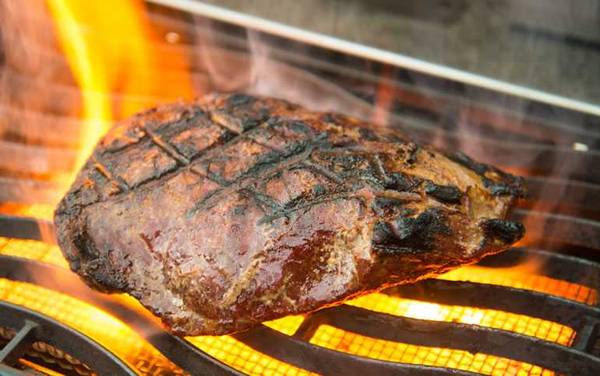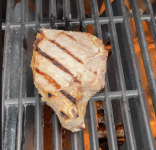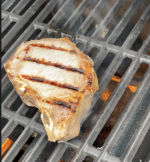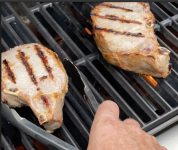Spirit II E-310 Gas Grill (Natural Gas) $639.00
My original review to Weber (hey, they asked!) :
Not great for searing, does other stuff well.
Bought this grill in late June, 2022 from a local small hardware store after doing lots of online research. Assembly went smoothly, and the construction seems pretty solid. The grill did have one bent leg, which may have occurred in shipping, but I was able to get it straightened out adequately after a few minutes.
It's a good looking grill. Controls work smoothly, fit and finish are good, and the features are about what I'd expect for a grill at this price point.
It starts up easily and heats to temp in about ten minutes. It'll max out the thermometer, at about 600 degrees.
My only gripe about the grill is that it doesn't sear well. Actually, in the technical sense, not at all.
The grill will get very hot, and it's good for cooking chicken, hot dogs, burgers... But it won't put even a slight char on a piece of meat.
-Sure, you'll get darker marks from the grates, but the rest of the meat doesn't get any char (between the lines).
Three different times now, I've cooked a nice pork tenderloin in a sous vide, and tried to finish it by searing on this grill. The grill just won't sear it. I COULD get it to char if I left the meat on there longer, but then it overcooks.
-Additionally, when grilling corn on the cob, if you like some nice charred spots, forget it, unless you are willing to leave it on the grill for awhile, and don't mind the corn overcooked.
I'm going to hazard a guess that the flames are just to far away from the grate to be able to sear, so you get more of a high-heat baking effect. When searing pork tenderloins on my
charcoal Weber, where I can get the coals as close to the meat as I'd like, results are perfect.
I've also tried just cooking a ribeye (1.25" thick) on the grill - and while I get brown grate marks, the rest of the meat doesn't brown before the ribeye is done.
This is probably a decent grill for cooking burgers, chicken or other things that require indirect heat, but it's not ideal for more direct heat applications.
Recommends this product
✘ No
-------------------------------
Weber's response was to make sure the lid stayed closed and preheat for 15 minutes.
-OK, so I understand that some people need these instructions. The same ones that need you to tell "not to stand on aluminum ladder, in a pool, with an extension cord in your teeth."
A few days later I got an email from Weber telling me they'd like to help, so I sent them similar, but expanded information from my review. As follows:
"Hello,
I'm having an issue with my new (Purchased in June 2022) Weber grill. I've tried to work with Weber customer service, but have not received timely answers. My ticket number is 2854***
I'd like to speak with a technical rep, or anyone else in customer service who may be able to help.
The problem I'm having centers around the grill not being able to sear at all. I believe it's a design issue. I'm not satisfied with this grill and would like your assistance in coming to a resolution.
Rob Smith
robs************.com
Original ( and second) email to Weber:
"-I read the Weber response on the website about my review, and it suggested keeping the lid closed and pre-heating for 15 minutes.
I was already following that procedure, and in addition, I ensured that the grill was turned up as high as it would go to get the most heat (600+ degrees, according to the thermometer in the grill). Still no satisfaction on getting a sear on meat. Please note, I have used this grill about 6 times now.
The burners are just too far away from the grates to get any kind of actual sear. (And I'm really not talking about a serious "Burn-it-up" type char...just a nice searing to make the meat look browner and a little crisp to it.)
So, having spent almost $600 on this grill, I can't really just go out and buy another- better one. I'm kind of stuck with what I have, unless your customer service team can come up with another idea.
And then I could write a review about the awesome Weber Customer Service!
By the way: Sous Vide cooking (What I was talking about in my original note) is really gaining popularity, and it invariably requires a cast iron skillet, charcoal, or gas grill to finalize the process and sear the meat (as it comes out of the sous vide kind of grey).
-And yes, I dry the meat with paper towels before throwing it on the grill because wet meat won't sear well.
Since more and more people are using this method to create a very nice dinner - often on expensive cuts of meat - I might suggest having Weber designers take a look at this, and all their grills, to ensure that they can sear well, otherwise you can probably expect more reviews like mine... from less than satisfied customers.
Looking forward to your response.
Feel free to contact me if you come up with other ideas, or would like further.
Rob"
-------------------------------
After not hearing from them for over a week, I found their customer service number and called. I reached a nice young gentleman who looked up my ticket number and said they'd never received my response email and indicated that their servers were down the week before, so a lot of emails didn't get through. We talked for a few minutes, where he repeated the advice to keep the lid closed and preheat for 15 minutes....and from what I could understand, said he'd get my complaint to a person more technical so I could get a proper response. I was having dificulty understanding because English IS my only language, and he didn't vocalize words I'm familiar with very well.
Over the last couple weeks I've gotten two other emails from Weber. One asking me to rate how well they solved my problem, and another stating "Thank you for your reply. What temperature does the grill reach with all the burners on high for 15 minutes?" Response time from them is very slow, and to date, very unhelpful.
I've gotten a little pre-advice from a couple others on this forum (Thanks much!) but at this point, I'd rather not modify my grill, or stick to cooking things that don't need to be seared.
To sum: The grill seems to heat to proper temp -in a normal time (600+ degrees, verified with an oven thermometer in addition to the Weber thermometer). The grates get hot enough to leave brown stripes, but the meat will not sear - unless left on the grill way past the "well done" stage".
So. I'm just about to the point where I give up being nice, and lay out some reviews on different sites to let more people know that this grill won't sear.
I'm also to the point where my displeasure with Weber customer service is going to leak into the reviews.
Apologies for the enormity of this post, If you've stuck with me so far, give me a holler. You and I can be best friends and I'll buy you a beer next time you're between Daytona and Orlando

Cheers!





